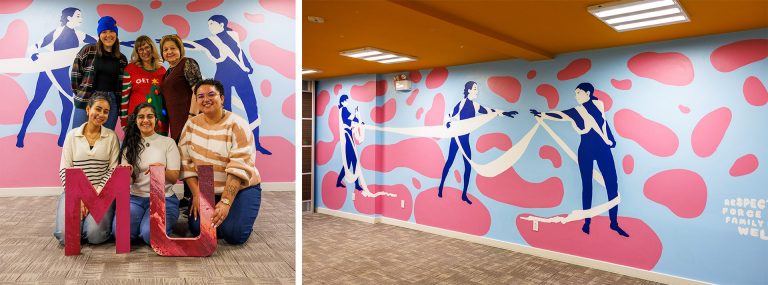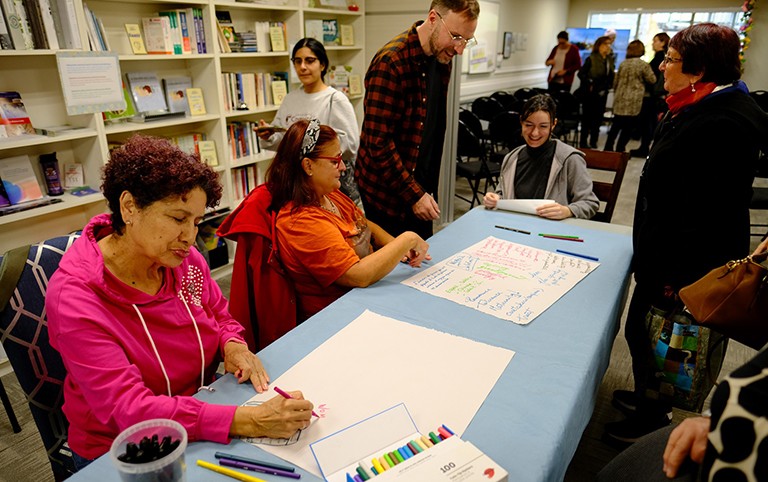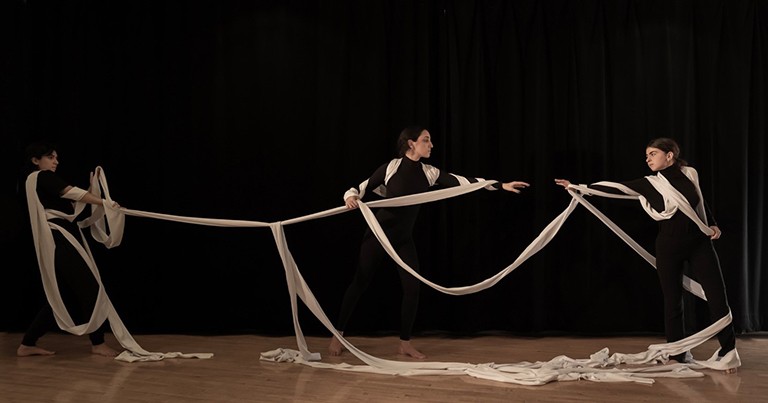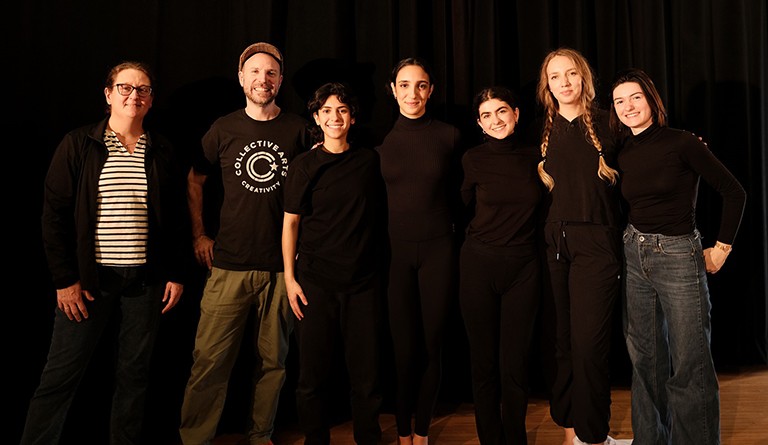Concordia Fine Arts students collaborate with women’s centre to produce a new mural celebrating justice and equality

A group of Concordia Fine Arts students has designed and painted a new mural at the Centre des femmes solidaires et engagées (CFSE), a women’s centre in Montreal.
The mural, “Force/Accueil,” was inaugurated on December 18. It was produced under the guidance of multidisciplinary contemporary artist Israël Dupuis, MFA 02, a part-time faculty member in Concordia’s Department of Design and Computation Arts.
The project is part of an experiential learning initiative in Dupuis’s course DART 453: Design and Community Engagement in the Faculty of Fine Arts. The course is also open to those enrolled in the Loyola College for Diversity and Sustainability’s Minor in Diversity and the Contemporary World.
“This project holds a lot of meaning for me as a former Concordia student,” says Pina Di Pasquale, GrDip 00, executive director of the CFSE.
“I felt an overwhelming joy before Israël even finished explaining the project. My lifelong dream for the Centre was realized!”
 Professor Israël Dupuis and his students worked with women at the Centre to co-create the vibrant mural.
Professor Israël Dupuis and his students worked with women at the Centre to co-create the vibrant mural.
Social impact via hands-on learning
The project is supported by a partnership with MU Montreal. The group is known for creating the city’s famous Leonard Cohen Crescent Street Mural as well as its commitment to social impact through art.
Dupuis notes that “Force/Accueil” was created in part to spark discussions with his students about social justice and community support. “Experiential learning is crucial,” he says.
“It transforms students from passive recipients of information into active participants in real-world projects with significant stakes. This approach dramatically boosts their engagement in a way that traditional classroom-based learning simply cannot match.”
Dupuis points out that added benefits include helping students understand gender inequality, encouraging them to advocate for those in need, and considering these ideas in their professional choices and practices.
“The mural serves as a visual representation of the centre’s mission. It’s a beacon of hope, inspiration and empowerment for generations to come,” Di Pasquale adds.
“It stands not merely as strokes on a wall; it represents the stories of courage, determination and the unwavering pursuit of equality that echo within the walls of our centre.”
“This artwork symbolizes our commitment to creating a world where every woman’s voice is heard. It is a tribute to the resilience and strength of all women.”
 Concordia theatre students choreographed a tableau vivant based on the women's stories as a basis for the mural.
Concordia theatre students choreographed a tableau vivant based on the women's stories as a basis for the mural.
Visualizing justice
While seeking ways to integrate his art practice into his teaching at Concordia, Dupuis joined the City School program, which brings universities and city staff to work together to tackle urban challenges. City School is led by Maude Lecourt, part-time faculty in the university’s Department of Geography, Planning and the Environment and senior lead, partnerships and cities, in the Office of the Provost and Vice-President, Academic.
“The CFSE has long been a sanctuary for all who knock at our door,” Di Pasquale says. “The centre’s history and mission — over 45 years of feminist struggles, great achievement and militant women — summarizes our merit for a wall mural.”
“Force/Accueil” graces an interior wall in the centre’s activity room. Throughout the mural’s conception, Dupuis’s students collaborated with the CFSE, actively involving members of the centre, creating a space for idea exchanges and fostering a dialogue around the unique challenges women face.
“Murals, which are inherently collaborative, seemed a perfect medium,” Dupuis explains.
“In creating this mural, my goal was to forge a powerful visual representation of these women’s struggles and triumphs. Their enthusiasm was palpable. Themes like women’s rights, justice, and family emerged as focal points.”
Undergraduate India-Lynn Upshaw-Ruffner, one of Dupuis’s students, says she appreciated working with the women from the centre throughout the process.
“We ran a workshop with the women to learn what the centre brought to them, and then we came together to paint the mural with artist Diane Roe from MU,” Upshaw-Ruffner recounts. “And now it brightens up the centre every day and is a great conversation piece.”
 City School's Maude Lecourt and Concordia prof Israël Dupuis collaborated with Concordia students Nicole Bejarano-Libreros, Lamia Abou Karam, Julia Pye, Gabriela Petrov and Adele Louchet.
City School's Maude Lecourt and Concordia prof Israël Dupuis collaborated with Concordia students Nicole Bejarano-Libreros, Lamia Abou Karam, Julia Pye, Gabriela Petrov and Adele Louchet.
‘The power of interdisciplinary collaboration’
Dupuis and his students also collaborated with peers from a Concordia Department of Theatre class taught by part-time faculty member Gabriela Petrov, BFA 16. Several student actors were directed to embody the themes in a movement performance, which was then photographed.
The photos served as a reference point for the mural and provided a valuable collaborative opportunity for everyone involved.
For Julia Pye, one of Petrov’s theatre students, performing in the movement piece was especially impactful.
“It was an honour to be able to use my studies to contribute to a real, tangible piece of art outside of an academic environment, especially for something so meaningful,” she says.
“Having artists from different disciplines come together to co-create infuses projects with so much more emotional depth. It’s very cool to have that immortalized on a wall at the centre.”
Dupuis and Petrov had previously collaborated on a spontaneous installation at Hangar 7826 titled “Territoires/Dimension.” He says he knew the collaboration would be a success based on this past experience.
“I greatly appreciate Gabriela’s sense of movement. It brings a striking and emotive quality to my work, especially when I use photographs of her performances in my compositions,” Dupuis says.
“The photo shoot was integral to the mural’s conception. The theatrical expressions and movements captured were perfectly aligned with the overarching themes and objectives of the mural.”
The mural was painted over several days during the first few weeks of December, and its official inauguration was held at the CFSE on December 18.
“It’s been incredibly rewarding to see how art can serve as a bridge between different groups and perspectives, fostering a sense of unity and shared purpose,” Dupuis says.
“This project has reinforced my belief in the power of interdisciplinary collaboration. Bringing together students from different backgrounds and specializations has enriched the project far beyond what could have been achieved in a more siloed approach,” he adds.
“It’s a testament to the fact that when diverse skills and viewpoints converge, the creative possibilities are boundless.”
Discover the human side of design in Concordia’s Bachelor of Fine Arts – Design.
Do you have questions or want to explore potential ideas to collaborate with City School? Visit the new City School web page to learn more.


